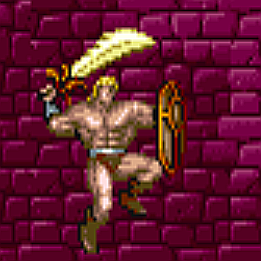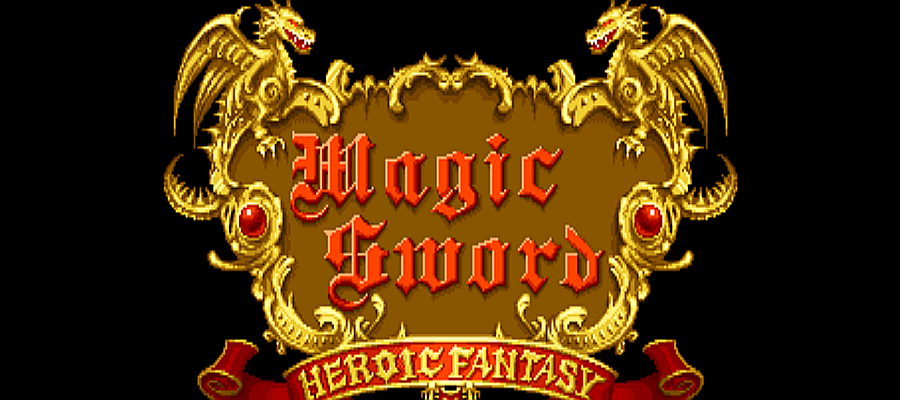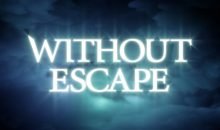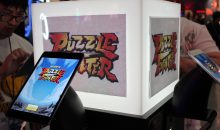Magic Sword: Arcade Pixels & Pectorals
As planning for my wedding ramps up and my work weeks become longer, I’ve been spending more and more time revisiting the simple joys of arcade games. I know that I can’t be completely certain whether or not I’m wrapping myself in the warm blanket of nostalgia or if these games are actually holding up over time, but I’m finding the bright colors and quick action of arcade games a welcome diversion.
The game that got me back into the arcade scene was Capcom’s Magic Sword, mostly thanks to the Game Grumps picking it up themselves. I couldn’t be more pleased with it, it’s a 2d sidescrolling brawler with some very clever innovations and a polished presentation. First in arcades in 1990, then ported to the Super Nintendo in 1992, and more recently available on XBLA and PSN platforms in 2010, it has aged well. But there is no shortage of side scrolling arcade games from this era, what makes Magic Sword stand apart?
Peerless Pointed Play
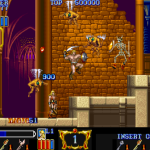 Magic Sword is only as complicated as is necessary: the evil lord Drokkmar is chilling out a the top of a 50 story tower and unless you can pilot a shirtless hero to the top, Drokkmar will surely rule the world using his Black Orb. How exactly this will come about we can’t be sure, but we do know that there are 50 levels of badguys to chop through! The controls are simple: you have a joystick for movement, a button to swing your sword, a button to jump, and if you press both buttons together you can unleash a limited-use screen-clearing spell. It’s your job to walk to the right while slaughtering hordes of enemies and jumping over hazards until you get to the end of each level. (Or your health runs out.) A few blasé boss fights will punctuate your ascent.
Magic Sword is only as complicated as is necessary: the evil lord Drokkmar is chilling out a the top of a 50 story tower and unless you can pilot a shirtless hero to the top, Drokkmar will surely rule the world using his Black Orb. How exactly this will come about we can’t be sure, but we do know that there are 50 levels of badguys to chop through! The controls are simple: you have a joystick for movement, a button to swing your sword, a button to jump, and if you press both buttons together you can unleash a limited-use screen-clearing spell. It’s your job to walk to the right while slaughtering hordes of enemies and jumping over hazards until you get to the end of each level. (Or your health runs out.) A few blasé boss fights will punctuate your ascent.
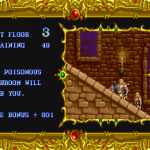
Unlike some of the more popular brawlers from the ’90s, Magic Sword is a strictly 2 dimensional affair ala Mario, but the game introduces an ally system that is the real crux of what makes Magic Sword so interesting. Through out the tower, you will find jail cells that can be opened using keys found in chests. Opening a cell will release a randomly selected ally that will follow faithfully. Your allies can range from Amazons that shoot multiple arrows when you swing your sword, thieves that detect secret chests and toss bombs, and even wizards that shoot homing missiles. Your allies will inevitably fall before you do, but this tower is lousy with heroes. The swapping of allies really makes what would be an otherwise standard sidescroller into a fresh experience that’s constantly changing.
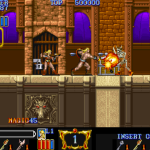 The game also provides a satisfying amount of character progression as you climb the tower, something that most arcade games don’t offer. As you defeat bosses your sword will be upgraded, allowing you to eventually toss fireballs and even shoot lightning bolts across the screen as you attack. Your followers will also level up provided they survive long enough. (For example, a ninja ally will throw more and more shurikens, eventually upgrading to flaming discs that home in on enemies.) Turning previously troublesome enemies into mulch is especially satisfying when your quarters are on the line.
The game also provides a satisfying amount of character progression as you climb the tower, something that most arcade games don’t offer. As you defeat bosses your sword will be upgraded, allowing you to eventually toss fireballs and even shoot lightning bolts across the screen as you attack. Your followers will also level up provided they survive long enough. (For example, a ninja ally will throw more and more shurikens, eventually upgrading to flaming discs that home in on enemies.) Turning previously troublesome enemies into mulch is especially satisfying when your quarters are on the line.
Perfect Pectoral Presentation
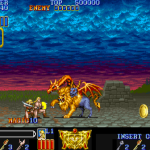 While the arcade cabinets of this era were able to push out higher quality graphics and sound than any home console could, that didn’t guarantee you were getting a game that was assembled with skill and care. Thankfully, Magic Sword is a perfectly preserved diorama of expertly executed ’90s tropes.
While the arcade cabinets of this era were able to push out higher quality graphics and sound than any home console could, that didn’t guarantee you were getting a game that was assembled with skill and care. Thankfully, Magic Sword is a perfectly preserved diorama of expertly executed ’90s tropes.
The character and monster designs, in particular, are pure ’90s cheese and it’s a sight to behold. Your hero is the tiny-headed, massive-pec’ed, greased-up Schwarzeneggerian hero that every TV show and movie portrayed. Your allies range from oddly-muscular and overly-breasted Amazons to Andre the Giant lookalikes. Even the enemies follow the He-Man approach where every creature that could possibly have abs has them in abundance. And the villains come in two varieties: floating Fu Manchu mustache wearing wizards and twenty foot tall Skelletors.
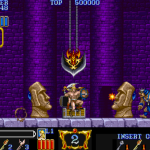 As you traverse the 50 levels of the tower you’re going to see plenty of repeated environments, but they are all colorful and vibrant. Even the power ups are unique, making everything instantly recognizable. The designers of this game knew what they were doing, everything is engaging and really pops out in the midst of the action.
As you traverse the 50 levels of the tower you’re going to see plenty of repeated environments, but they are all colorful and vibrant. Even the power ups are unique, making everything instantly recognizable. The designers of this game knew what they were doing, everything is engaging and really pops out in the midst of the action.
The music itself is what you’d expect. There are far too few tracks to cover 50 floors worth of gameplay and they do become repetitive by the end, but they are the harmless, fade-into-the-background thumping semi-medieval techno tracks we enjoyed from all fantasy arcade games. The soundtrack is par for the course given the context, but it’s easily the weakest part of the game. Also, your Conan hero will go HEEYAAA every time you swing your sword when it’s at full power. Be ready for that.
A Prominent Pastime Prescription
Magic Sword is the best of early ’90s arcade games. One can wrap their head around it in five seconds, before you know it you’re climbing 50 floors of a brutally challenging tower to save the day. Add in the satisfaction of leveling up your hero and choosing allies and you have a game that remains interesting far longer than most brawlers would. The fact that this game is once again available through XBLA and PSN (in a bundle with the venerable Final Fight) makes this a game that I can heartily recommend.
Sure, it’s ’90s cheese cake, but it is a worthwhile indulgence.

